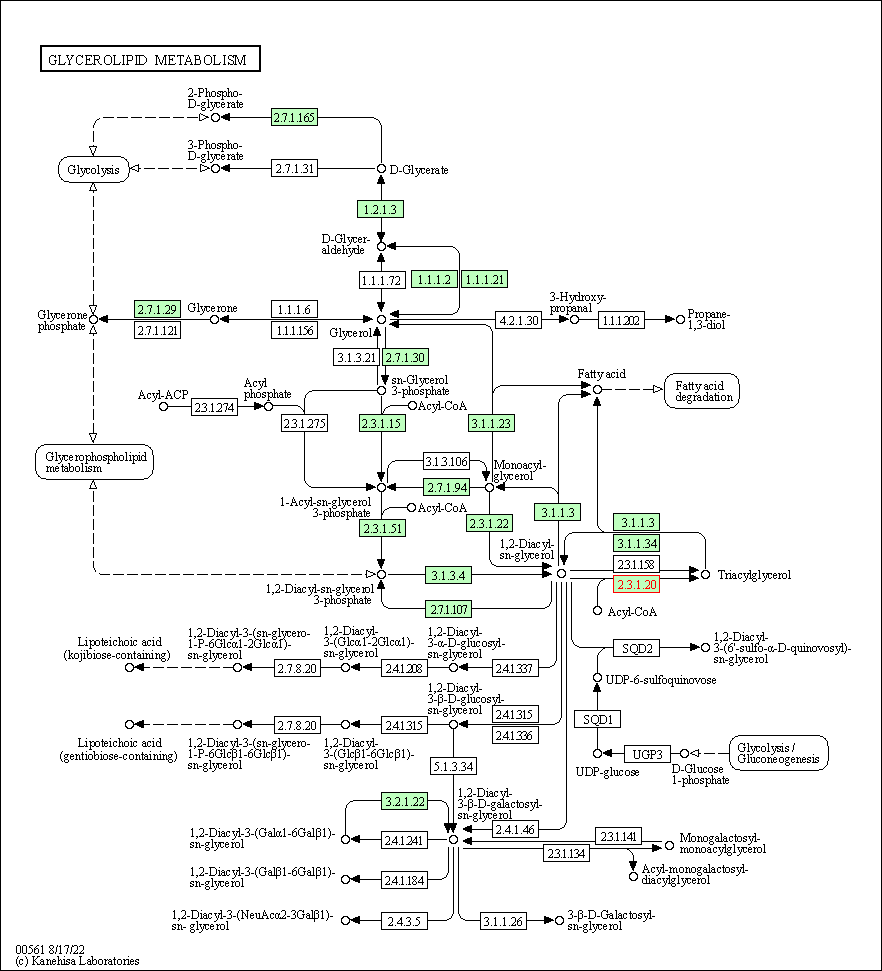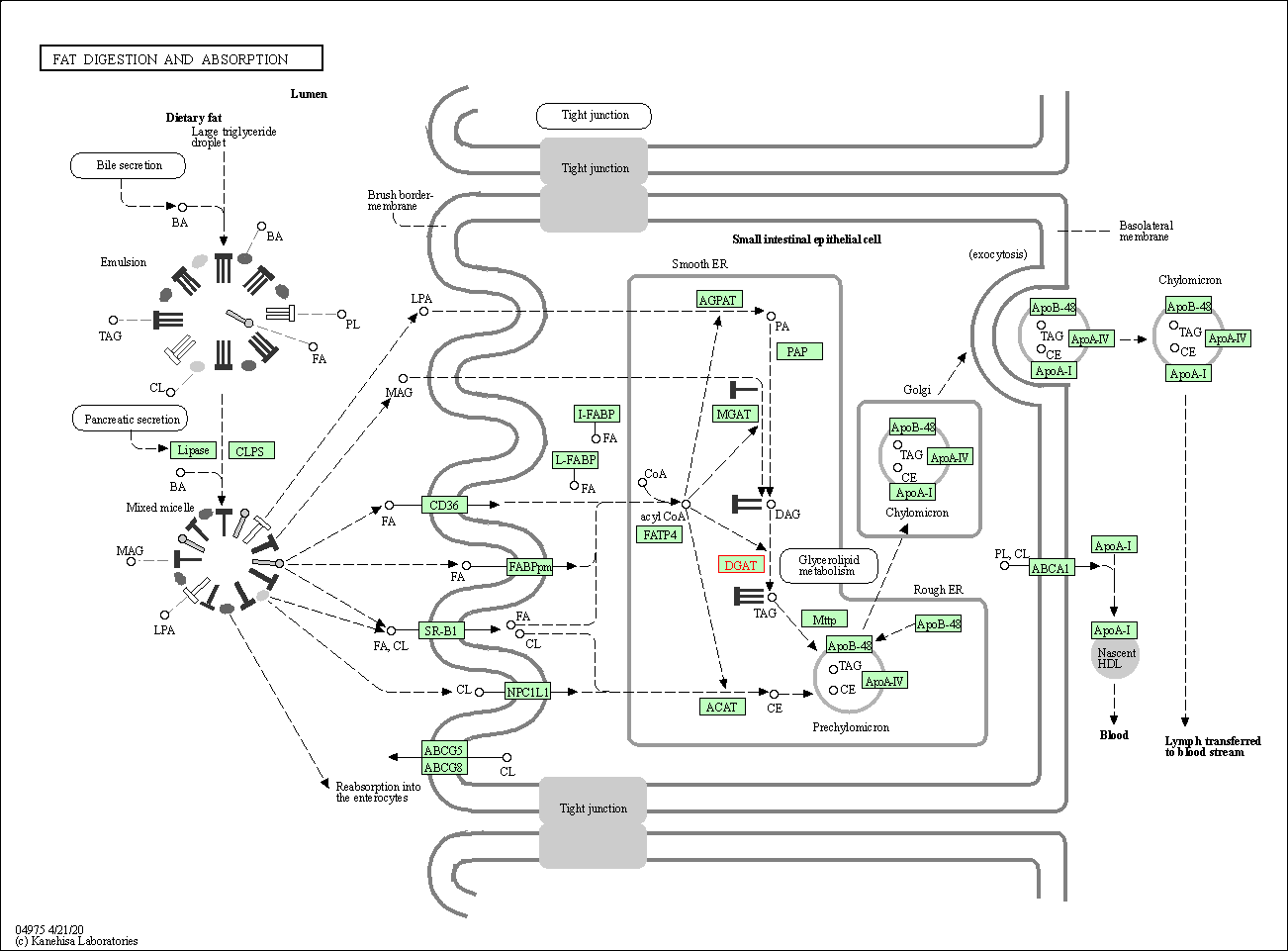Target Information
| Target General Information | Top | |||||
|---|---|---|---|---|---|---|
| Target ID |
T95558
(Former ID: TTDS00531)
|
|||||
| Target Name |
Diacylglycerol O-acyltransferase 2 (DGAT2)
|
|||||
| Synonyms |
UNQ738/PRO1433; HMFN1045; Diglyceride acyltransferase 2
Click to Show/Hide
|
|||||
| Gene Name |
DGAT2
|
|||||
| Target Type |
Successful target
|
[1] | ||||
| Disease | [+] 1 Target-related Diseases | + | ||||
| 1 | Inborn lipid metabolism error [ICD-11: 5C52] | |||||
| Function |
Required for synthesis and storage of intracellular triglycerides. Probably plays a central role in cytosolic lipid accumulation. In liver, is primarily responsible for incorporating endogenously synthesized fatty acids into triglycerides. Functions also as an acyl-CoA retinol acyltransferase (ARAT). Essential acyltransferase that catalyzes the terminal and only committed step in triacylglycerol synthesis by using diacylglycerol and fatty acyl CoA as substrates.
Click to Show/Hide
|
|||||
| BioChemical Class |
Acyltransferase
|
|||||
| UniProt ID | ||||||
| EC Number |
EC 2.3.1.20
|
|||||
| Sequence |
MKTLIAAYSGVLRGERQAEADRSQRSHGGPALSREGSGRWGTGSSILSALQDLFSVTWLN
RSKVEKQLQVISVLQWVLSFLVLGVACSAILMYIFCTDCWLIAVLYFTWLVFDWNTPKKG GRRSQWVRNWAVWRYFRDYFPIQLVKTHNLLTTRNYIFGYHPHGIMGLGAFCNFSTEATE VSKKFPGIRPYLATLAGNFRMPVLREYLMSGGICPVSRDTIDYLLSKNGSGNAIIIVVGG AAESLSSMPGKNAVTLRNRKGFVKLALRHGADLVPIYSFGENEVYKQVIFEEGSWGRWVQ KKFQKYIGFAPCIFHGRGLFSSDTWGLVPYSKPITTVVGEPITIPKLEHPTQQDIDLYHT MYMEALVKLFDKHKTKFGLPETEVLEVN Click to Show/Hide
|
|||||
| 3D Structure | Click to Show 3D Structure of This Target | AlphaFold | ||||
| HIT2.0 ID | T49M88 | |||||
| Drugs and Modes of Action | Top | |||||
|---|---|---|---|---|---|---|
| Approved Drug(s) | [+] 1 Approved Drugs | + | ||||
| 1 | Vitamin B3 | Drug Info | Approved | Lipid metabolism disorder | [1] | |
| Clinical Trial Drug(s) | [+] 3 Clinical Trial Drugs | + | ||||
| 1 | ARI-3037MO | Drug Info | Phase 2 | Cardiovascular disease | [2] | |
| 2 | PF-06865571 | Drug Info | Phase 2 | Non-alcoholic steatohepatitis | [3] | |
| 3 | PF-06427878 | Drug Info | Phase 1 | Hyperlipidaemia | [4] | |
| Mode of Action | [+] 1 Modes of Action | + | ||||
| Inhibitor | [+] 6 Inhibitor drugs | + | ||||
| 1 | Vitamin B3 | Drug Info | [1] | |||
| 2 | ARI-3037MO | Drug Info | [5] | |||
| 3 | PF-06865571 | Drug Info | [6] | |||
| 4 | PF-06427878 | Drug Info | [2] | |||
| 5 | PMID25470667-Compound-Figure4-1A | Drug Info | [7] | |||
| 6 | PMID25470667-Compound-roselipins | Drug Info | [7] | |||
| Cell-based Target Expression Variations | Top | |||||
|---|---|---|---|---|---|---|
| Cell-based Target Expression Variations | ||||||
| Different Human System Profiles of Target | Top |
|---|---|
|
Human Similarity Proteins
of target is determined by comparing the sequence similarity of all human proteins with the target based on BLAST. The similarity proteins for a target are defined as the proteins with E-value < 0.005 and outside the protein families of the target.
A target that has fewer human similarity proteins outside its family is commonly regarded to possess a greater capacity to avoid undesired interactions and thus increase the possibility of finding successful drugs
(Brief Bioinform, 21: 649-662, 2020).
Human Tissue Distribution
of target is determined from a proteomics study that quantified more than 12,000 genes across 32 normal human tissues. Tissue Specificity (TS) score was used to define the enrichment of target across tissues.
The distribution of targets among different tissues or organs need to be taken into consideration when assessing the target druggability, as it is generally accepted that the wider the target distribution, the greater the concern over potential adverse effects
(Nat Rev Drug Discov, 20: 64-81, 2021).
Human Pathway Affiliation
of target is determined by the life-essential pathways provided on KEGG database. The target-affiliated pathways were defined based on the following two criteria (a) the pathways of the studied target should be life-essential for both healthy individuals and patients, and (b) the studied target should occupy an upstream position in the pathways and therefore had the ability to regulate biological function.
Targets involved in a fewer pathways have greater likelihood to be successfully developed, while those associated with more human pathways increase the chance of undesirable interferences with other human processes
(Pharmacol Rev, 58: 259-279, 2006).
Biological Network Descriptors
of target is determined based on a human protein-protein interactions (PPI) network consisting of 9,309 proteins and 52,713 PPIs, which were with a high confidence score of ≥ 0.95 collected from STRING database.
The network properties of targets based on protein-protein interactions (PPIs) have been widely adopted for the assessment of target’s druggability. Proteins with high node degree tend to have a high impact on network function through multiple interactions, while proteins with high betweenness centrality are regarded to be central for communication in interaction networks and regulate the flow of signaling information
(Front Pharmacol, 9, 1245, 2018;
Curr Opin Struct Biol. 44:134-142, 2017).
Human Similarity Proteins
Human Tissue Distribution
Human Pathway Affiliation
Biological Network Descriptors
|
|
|
There is no similarity protein (E value < 0.005) for this target
|
|
Note:
If a protein has TS (tissue specficity) scores at least in one tissue >= 2.5, this protein is called tissue-enriched (including tissue-enriched-but-not-specific and tissue-specific). In the plots, the vertical lines are at thresholds 2.5 and 4.
|


| KEGG Pathway | Pathway ID | Affiliated Target | Pathway Map |
|---|---|---|---|
| Glycerolipid metabolism | hsa00561 | Affiliated Target |

|
| Class: Metabolism => Lipid metabolism | Pathway Hierarchy | ||
| Fat digestion and absorption | hsa04975 | Affiliated Target |

|
| Class: Organismal Systems => Digestive system | Pathway Hierarchy | ||
| Degree | 4 | Degree centrality | 4.30E-04 | Betweenness centrality | 6.94E-04 |
|---|---|---|---|---|---|
| Closeness centrality | 1.67E-01 | Radiality | 1.26E+01 | Clustering coefficient | 0.00E+00 |
| Neighborhood connectivity | 2.75E+00 | Topological coefficient | 2.92E-01 | Eccentricity | 12 |
| Download | Click to Download the Full PPI Network of This Target | ||||
| Chemical Structure based Activity Landscape of Target | Top |
|---|---|
| Co-Targets | Top | |||||
|---|---|---|---|---|---|---|
| Co-Targets | ||||||
| Target Poor or Non Binders | Top | |||||
|---|---|---|---|---|---|---|
| Target Poor or Non Binders | ||||||
| Target Affiliated Biological Pathways | Top | |||||
|---|---|---|---|---|---|---|
| BioCyc | [+] 1 BioCyc Pathways | + | ||||
| 1 | Triacylglycerol biosynthesis | |||||
| KEGG Pathway | [+] 3 KEGG Pathways | + | ||||
| 1 | Glycerolipid metabolism | |||||
| 2 | Metabolic pathways | |||||
| 3 | Fat digestion and absorption | |||||
| Reactome | [+] 2 Reactome Pathways | + | ||||
| 1 | Acyl chain remodeling of DAG and TAG | |||||
| 2 | Triglyceride Biosynthesis | |||||
| WikiPathways | [+] 3 WikiPathways | + | ||||
| 1 | Triacylglyceride Synthesis | |||||
| 2 | Glycerophospholipid biosynthesis | |||||
| 3 | Fatty acid, triacylglycerol, and ketone body metabolism | |||||
| References | Top | |||||
|---|---|---|---|---|---|---|
| REF 1 | Hakozaki T, Minwalla L, Zhuang J, Chhoa M, Matsubara A, Miyamoto K, Greatens A, Hillebrand GG, Bissett DL, Boissy RE: The effect of niacinamide on reducing cutaneous pigmentation and suppression of melanosome transfer. Br J Dermatol. 2002 Jul;147(1):20-31. | |||||
| REF 2 | Clinical pipeline report, company report or official report of the Pharmaceutical Research and Manufacturers of America (PhRMA) | |||||
| REF 3 | ClinicalTrials.gov (NCT04321031) A PHASE 2, RANDOMIZED, DOUBLE-BLIND, DOUBLE-DUMMY, PLACEBO-CONTROLLED, DOSE-RANGING, DOSE-FINDING, PARALLEL GROUP STUDY TO ASSESS EFFICACY AND SAFETY OF PF-06865571 (DGAT2I) ALONE AND WHEN COADMINISTERED WITH PF-05221304 (ACCI) IN ADULT PARTICIPANTS WITH BIOPSY-CONFIRMED NONALCOHOLIC STEATOHEPATITIS AND FIBROSIS STAGE 2 OR 3. U.S.National Institutes of Health. | |||||
| REF 4 | ClinicalTrials.gov (NCT02208284) A Single Oral Dose Study Of PF-06427878 In Healthy Adult Subjects. U.S. National Institutes of Health. | |||||
| REF 5 | 2011 Pipeline of Arisaph Pharmaceuticals. | |||||
| REF 6 | Discovery of Ervogastat (PF-06865571): A Potent and Selective Inhibitor of Diacylglycerol Acyltransferase 2 for the Treatment of Non-alcoholic Steatohepatitis. J Med Chem. 2022 Nov 24;65(22):15000-15013. | |||||
| REF 7 | Acyltransferase inhibitors: a patent review (2010-present).Expert Opin Ther Pat. 2015 Feb;25(2):145-58. | |||||
If You Find Any Error in Data or Bug in Web Service, Please Kindly Report It to Dr. Zhou and Dr. Zhang.

